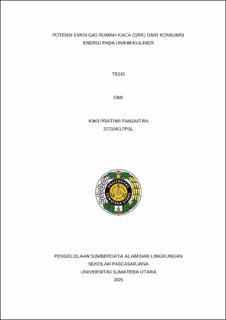Potensi Emisi Gas Rumah Kaca (GRK) Dari Konsumsi Energi Pada UMKM Kuliner
Greenhouse Potential Emissions From Energy Consumption In Culinary MSME

Date
2025Author
Panjaitan, Kiki Pratiwi
Advisor(s)
Husin, Amir
Aththorick, T Alief
Metadata
Show full item recordAbstract
Each year, the earth's surface temperature has increases due to activities
carried out by individuals or companys. One way to find out the amount of
emissions generated by human activities is through the calculation of the carbon footprints. Micro, Small Medium Enterprise (MSME) business operators have the potential to contribute to the carbon footprints originating by the use of Liquefied Petroleum Gas (LPG), fuel, and electricity. This study is necessary as a preliminary analysis to understand the greenhouse gas (GHG) emissions burden generated from energy consumption (electricity and LPG) and fuel usage by MSME business operators. It also aims to find the proper management strategies to reduce the GHG carbon footprint produced. To calculate the carbon footprint, the method used is the methodology set by the Intergovernmental Panel on Climate Change (IPCC, 2006). The analysis results show that the largest emission sources from culinary MSME activities are restaurants, with approximately 3,079 CO2eq/year, followed by fried chicken at an average of 2,682 CO2eq/year, and meatball soup at around 2,504 CO2eq/year.The MSME with the highest income is Fried chicken, with an average monthly revenue of IDR 19,225,000, while the lowest income is from siomay at IDR 7,700,000 per month. Income has an impact of 93.3% on the carbon footprints. Management measures that can be taken include analyzing which stages of the production process require significant energy, so strategies can be formulated to reduce the emissions produced. Additionally, the government should promote carbon-saving movements and educate the public about energy-efficient household appliances.
